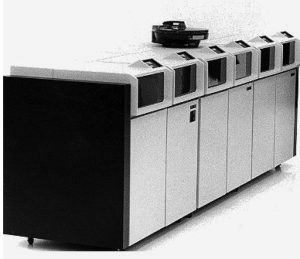History (1973): Winchester Pioneers Key HDD Technology
IBM 3340 employs new low-cost, low-load, landing R/W heads.
This is a Press Release edited by StorageNewsletter.com on March 22, 2018 at 2:34 pmThis article comes from the Computer History Museum.
1973: “Winchester” pioneers key HDD technology
IBM 3340 employs new low-cost, low-load, landing R/W heads
IBM 3340 direct access storage facility (1973)

(Courtesy International Business Machines Corporation)
In 1969, IBM charged San Jose project manager Kenneth E. Haughton with developing a ‘direct access storage facility’ that matched the performance of the high-end IBM 3330 system at a price attractive to low-end System/370 computer customers.
The IBM3340 HDD that began shipping in November 1973 pioneered new low-cost, low-load, landing R/W heads with lubricated disks, and established what became the dominant HDD technology.
Al Shugart identified this new Winchester head as one of the four most significant developments in mass storage.
Derived from the original specification of a system having two spindles each with a disk capacity of 30MB, Haughton is reported to have said: “If it’s a 30-30, then it must be a Winchester” after the .30-30 Winchester rifle cartridge.
With a load of less than 20 grams, the ferrite R/W head patented by team member Mike Warner started and stopped in contact with the disk on a dedicated landing zone but flew over the disk on an air bearing 18 microinches thick between the magnetic head and spinning disk.
The disks, spindle and bearings, head-positioning carriage and head-arm assemblies were all incorporated into a removable sealed cartridge called the IBM 3348 Data Module, invented by Richard B. Mulvany and Rudolf W. Lissner, with capacities of 35 and 70MB. A track density of 300tpi and an access time of 25ms were achieved.
The IBM Model 3350 (1975) turned the data module into a non-removable head disk assembly of 317MB capacity that some observers have called “the real Winchester” and that has remained the fundamental HDD packaging concept to the present day.














 Subscribe to our free daily newsletter
Subscribe to our free daily newsletter


